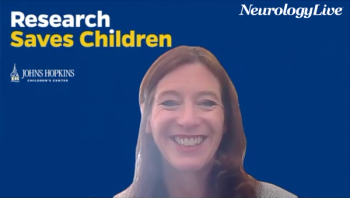
Utility of Helius’ Neuromodulation System to Treat Gait in Multiple Sclerosis
Antonella Favit-Van Pelt, MD, PhD, chief medical officer at Helius Medical Technologies, gave perspective on the clinical advantages of the company’s non-implantable device to treat gait in multiple sclerosis.
Difficulty in walking is among the most common mobility limitations in multiple sclerosis (MS). Such difficulties may be related to several factors, including ataxia, balance, fatigue, foot drop, sensory deficit, spasticity, and weakness. Most gait issues have been helped to some degree by physical therapy, stretching exercises, the use of appropriate assistive devices, and, in some cases, medications for spasticity, fatigue, and walking speed.
In March 2021, the FDA granted market authorization for Helius’ Portable Neuromodulation Stimulator (PoNS) as a new therapy for use during physical therapy to treat walking problems in those with MS. The device, intended only as adjunct to a supervised therapeutic exercise program, generates electrical pulses to stimulate nerves in the tongue, and in turn the brain, to treat motor deficits. This nonimplantable device includes a mouthpiece held in place by lips and teeth, as well as a control unit, worn around the neck.
A real-world study presented at the 2022 Consortium of Multiple Sclerosis Centers (CMSC) Annual Meeting showed that use of the PoNS therapy combined with a therapeutic exercise program significantly improved gait deficit at week 2, the earliest evaluated time point, and at every subsequent time point. At week 14, 58.3% of patients had a Functional Gait Assessment improvement of at least 4 points, surpassing the minimal detectable change for older adults, patients with stroke, and those with neurological disease.
Antonella Favit-VanPelt, MD, PhD, chief medical officer at Helius, provided commentary on the clinical application of the PoNS therapy to treat gait in MS, and some of the advantages it holds. In addition, she commented on the ways this neurostimulation approach has been enhanced since its inception, and whether there are certain intricacies clinicians should be aware of when prescribing to patients. Furthermore, she discussed how neurostimulation has opened the door for greater treatment opportunities in MS, as well as the types of research still needed to perfect this type of approach.
What are some of the main advantages or unique aspects of the PoNS device for patients with MS?
Antonella Favit-VanPelt, MD, PhD: PoNS, short for Portable Neuromodulation Stimulator, is an orally applied therapy delivered by neurostimulation through a mouthpiece connected to a portable controller. It’s used with physical rehabilitation exercise and improves gait in people with multiple sclerosis.
PoNS utilizes the brain’s innate ability to promote neuroplastic changes by stimulating two cranial nerves in the tongue and promoting neuromodulation of signaling pathways from brainstem to the cerebral cortex – specifically the dorsolateral prefrontal cortex, the anterior cingulate cortex, and the left motor cortex.Skin or neuromuscular stimulation devices, commonly used in MS rehabilitation, act peripherally and leverage physical therapy’s neuromodulation potential to improve the patient’s functional deficit. Conversely, PoNS is itself a neuromodulation therapy: Predominantly used by the patient at home, PoNS stimulates cranial (not peripheral) nerves that are directly connected to brain areas that regulate movement functions. PoNS stimulation, even before starting physical therapy, increases blood flow in these areas, promoting a sustainable neuromodulation and, over time, neuroplasticity. Unlike transcranial stimulation (TCS) in the lab, PoNS has the advantage of being readily accessible to the patient, allowing a great deal of autonomy and independence, empowering patients to use the system regularly and consistently at home and, as such, potentiate the neuromodulation mechanisms that lead to sustained neuroplasticity and, consequently, consolidated therapeutic effects.
From a clinician perspective, are there any complications with how it’s used or implemented? What should MS specialists be aware of when considering this product for their patients?
PoNS is a user-friendly therapeutic intervention that can be used by patients independently when performing their physical rehabilitation exercises. Patients are trained on PoNS utilization by their physical therapist, who activates the device and establishes/monitors the exercise program to be performed over the 14 weeks of treatment.It requires activation of the controller and adjustment of the stimulation intensity before and/or during utilization. The mouthpiece needs to be positioned in the tongue with good adherence to the tongue’s surface to deliver stimulation effectively.
Importantly, PoNS therapy exerts its effect by promoting neuroplasticity through regular and consistent physical rehabilitation of the impaired function. It relies on the patient’s commitment to perform regularly and consistently the recommended physical therapy program using the PoNS device as instructed. Efficacy is closely related to patients’ consistent at-home utilization during exercise and relaxation tasks for an average of 100 min per day. Clinical data demonstrate that patients who used the device at the recommended dose for 14 weeks improved significantly more than the control group.1,2
What are ways in which we can optimize the tool to its fullest potential? Especially to maintain long-term effectiveness?
If PoNS therapy is performed as recommended, it would trigger mechanisms of neuroplasticity that lead to gait improvement in MS patients. With regular and consistent PoNS utilization over 14 weeks, neuromodulation of brainstem and cortical areas engages physiologic mechanisms that promote a series of adaptive changes (neuroplasticity) that can rehabilitate corticospinal signaling mechanisms and lead to a therapeutic rehabilitative effect. The effect of neuroplasticity-mediated mechanisms is often sustained and likely to be maintained over time. Neurodegenerative disorders like MS, however, can have a progressive impact on the brain viability and may require additional neuromodulation interventions.
Partnering with a PoNS trained physical therapist (PT) is key to unlocking the therapeutic potential of this treatment.Although patients use the device primarily at home, they work with the therapist to achieve and monitor progress over the therapy’s course.In addition to adjusting the PT program, the therapist has the ability, at each visit, to download and review the activation data from the controller to ensure that the patient is using the device appropriately, retraining the patient if needed.
How has neurostimulation changed the way we treat patients with MS?
Neurostimulation recently has been at the forefront of rehabilitative therapy for its potential to leverage neuromodulation and trigger mechanisms in the central nervous system that can modulate brain activity to offset the impairment responsible for a functional deficit. Neurostimulation therapy can engage the peripheral nervous system, leveraging physical therapy to signal the brain through efferent corticospinal pathways or, like PoNS, act directly in the central nervous system by upregulating brain mechanism of neuroplasticity. Peripheral neurostimulation therapy has proven to be a therapeutic intervention that enhances the rehabilitative benefit of physical therapy.Central neurostimulation, especially when employed regularly and consistently like PoNS therapy, holds the therapeutic potential of leveraging the brain’s ability to repair and restructure the neural milieu for a more durable functional improvement.
Going forward, what other types of research do we need on the PoNS device?
The body of clinical and real-world evidence have demonstrated PoNS’s efficacy on gait deficit from MS and stroke,1-3 balance deficit from TBI, and, empirically, from other neurological disorders,1,4-6 suggesting that PoNS employs a mechanism of action likely to engage mechanisms that regulate gait and balance to compensate for the functional deficit in the relevant brain areas, regardless of the etiology of the underlying condition. Since PoNS’s therapeutic effect is intimately related to a regular and consistent application of the therapy, clinical research is ongoing to establish the relationship between treatment adherence and gait functional outcomes in MS patients. Under the FDA breakthrough designation for stroke, a registrational program is ongoing in North America to establish how PoNS therapy benefits stroke patients with gait and/or balance deficit. Along this research line, additional research exploring dosing, physical therapy regimen intensity, and adherence to treatment in patients with other neurological condition affecting lower limb mobility and coordination would contribute to enhance our understanding of the broader therapeutic potential of PoNS therapy.
REFERENCES
1.Tyler ME, Kaczmarek KA, Rust KL, Subbotin AM, Skinner KL, Danilov YP. Non-invasive neuromodulation to improve gait in chronic multiple sclerosis: a randomized double blind controlled pilot trial. J Neuroeng Rehabil. 2014 May 1;11:79. doi: 10.1186/1743-0003-11-79.
2. Leonard G, Lapierre Y, Chen JK, Wardini R, Crane J, Ptito A. Noninvasive tongue stimulation combined with intensive cognitive and physical rehabilitation induces neuroplastic changes in patients with multiple sclerosis: A multimodal neuroimaging study. Mult Scler J Exp Transl Clin. 2017 Feb 1;3(1):2055217317690561. doi: 10.1177/2055217317690561.
3.Galea MP, Cofré Lizama LE, Bastani A, Panisset MG, Khan F. Cranial nerve non-invasive neuromodulation improves gait and balance in stroke survivors: A pilot randomised controlled trial. Brain Stimul. 2017 Nov-Dec;10(6):1133-1135. doi: 10.1016/j.brs.2017.08.011. Epub 2017 Sep 20.
4. Bastani A, Cofré Lizama LE, Zoghi M, Blashki G, Davis S, Kaye AH, Khan F, Galea MP. The combined effect of cranial- nerve non-invasive neuromodulation with high-intensity physiotherapy on gait and balance in a patient with cerebellar degeneration: a case report. Cerebellum Ataxias. 2018 Mar 5;5:6. doi: 10.1186/s40673-018-0084-z.
5. Diep D, Lam ACL, Ko G. A Review of the Evidence and Current Applications of Portable Translingual Neurostimulation Technology. Neuromodulation. 2021 Dec;24(8):1377-1387. doi: 10.1111/ner.13260. Epub 2020 Sep 3.
6. Lynch P, Roberts D, Monaghan K. Translingual Neurostimulation for Peripheral Motor Control Recovery Post in- Patient Stroke Rehabilitation: A Focus Article. J Alzheimer’s Neurodegener Dis 2020 6, 038.
Newsletter
Keep your finger on the pulse of neurology—subscribe to NeurologyLive for expert interviews, new data, and breakthrough treatment updates.









































